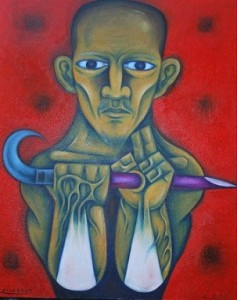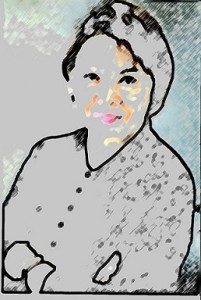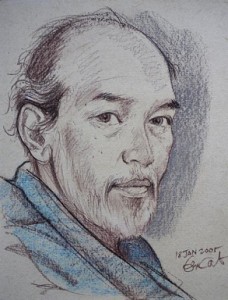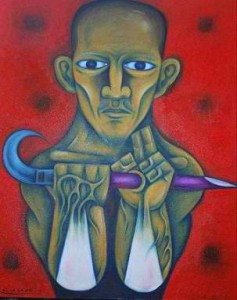By YOLANDA L. PUNZALAN
 SINCE most Filipinos have yet to develop the habit of visiting museums regularly, the Metropolitan Museum of Manila and the SM Malls have joined hands to bring genuine art from the museums to the malls.
SINCE most Filipinos have yet to develop the habit of visiting museums regularly, the Metropolitan Museum of Manila and the SM Malls have joined hands to bring genuine art from the museums to the malls.
“AKO,” a traveling exhibit of self-portraits done by masters of the visual arts from the 1800s to the present is on its last leg at the SM Mall of Asia.
The works of Jose Rizal, Rafael Enriquez, Jose Joya, Jose Garcia Villa, Victorio Edades, Vicente Manansala, J. Elizalde Navarro, Federico Aguilar Alcuaz, Jerry Araos, Bencab, Santi Bose, Juvenal Sanso, Romulo Galicano, Pandy Aviado, Nunelucio Alvarado, Fernando Modesto, Waldy Villanueva, Noell El Farroll, Kiko Escora, Mark Orozco Justiniani, Charlie Co, Claude Tayag, Wyg Tysman, Diokno Pasilan, Bebot Meru and Doods Busmente are all included as are the women: Agnes Arellano, Imelda Cajipe-Endaya, Karen Flores, Imelda Lacorte, Aileen Lanuza, Julie Lluch, Lenore R.S. Lim and Phyllis Zaballero.
The oldest work is of a chubby-cheeked Rizal, a drawing torn at the edges. He is shown looking down, wearing no top, his hair thick and oiled.
An 1878 watercolor on paper by Enriquez, entitled “Granada Enero,” is on loan from Luis Araneta’s family.
Like his comma poems, Garcia Villa still manages to spring a surprise with pencil sketch on paper, drawn in 1971. In it his face is depicted as half of a cone, with one eye, one ear, one nostril and a pair of half lips. It’s a conical drawing , uncolored, but nonetheless priceless as this was made by a poet declared a National Artist for Literature in 1973.
 Bencab’s pastels, done on handmade paper five months apart, reminds one of how Van Gogh made himself his own subject in a span of three years, producing 30 mirror images of himself in various seasons and shades of natural light.
Bencab’s pastels, done on handmade paper five months apart, reminds one of how Van Gogh made himself his own subject in a span of three years, producing 30 mirror images of himself in various seasons and shades of natural light.
Sanso’s undated oil painting on canvas shows his patrician self with eyes as blue as his blue silk dress shirt.
Joya sports a wintry look in his self-portrait done in 1985 in Firenze, Italy. It shows him enjoying a holiday, not unlike images found on Christmas cards. His fingers are plump, his neck warmed by a fleece scarf, his head protected by a soft bonnet. He wears a chic, expensive-looking pair of eyeglasses, undoubtedly Cartier.
Bose puts something hallucinogenic and magical in his two renderings of himself spaced seven years apart. His 1976 mixed media portrait is of a young man, with a body divided into three sections, each part a separate door panel, like what a magician does to a audience volunteer. Instant photo booth film negatives of a young boy are near Bose’s head while the same kind of negatives of a pretty woman are near his feet.
His 1983 mixed media, “Eyes of Gauze,” has him wearing a pink neck scarf. His fingers clasp a paintbrush. A tiny Sun Maid raisin box logo appears on the upper left corner while a bunch of fruits are way above his head, serving like his light.
Manansala’s “Sabongero” has him wearing a white kerchief around his forehead, loose lemon green trousers and a white sleeveless undershirt while carrying a handsome red and yellow rooster with shiny black tail feathers and black feet. The painter seems comfortable with the animal whose black talons are angled for a pounce.
 Aguilar Alcuaz’s painting shows his left hand holding a brush that seems to float, not connected to his body. Galicano’s “The Young Atlas” has him working in his studio, studying a young male nude whose back is turned. A large nude painting is positioned above the painter while a sculpted nude woman is by his right foot.
Aguilar Alcuaz’s painting shows his left hand holding a brush that seems to float, not connected to his body. Galicano’s “The Young Atlas” has him working in his studio, studying a young male nude whose back is turned. A large nude painting is positioned above the painter while a sculpted nude woman is by his right foot.
Zaballero’s “Malate Dreaming,” oil and photo transfer on canvas, shows her taking a break while painting. Her childhood photo with her dad is pasted on the right and a solo yellow flower in a simple glass vase sits on the left. The color of blood seems to break the peace of this work.
Lluch’s “Philippine Gothic” is a faithful terracotta rendition of her lush, center-parted hair reaching to her cleavage, slim waist, slim arms, long graceful fingers. She wears a comfortable blouse.
Alvarado’s “Ako, Ako, Ako” shows a strong man with veins popping out to display his strength as he holds a scythe with a lavender rod.
Unique is Lim’s self-portrait done with giclee and ink jet. It’s a silhouette of her head and half body in a black-buttoned dress. The effect is like a film negative. Her face seems to have no features until the colors give some life–baby yellow, light orange, and hot pink for her lips. This face is surrounded by splashes of blue green above her head.
Why do artists do self-portraits? Perhaps, they want to capture their inner self, their experiences, even changes in fortune. Van Gogh did self-portraits because he had no money to pay his models; it was also his way of perfecting his style, He wrote to painter Emile Bernard: “I strongly urge you to study portrait painting, do as many portraits as you can and don’t flag. We must win the public over later on by means of the portrait; in my opinion, it is the thing of the future.”
